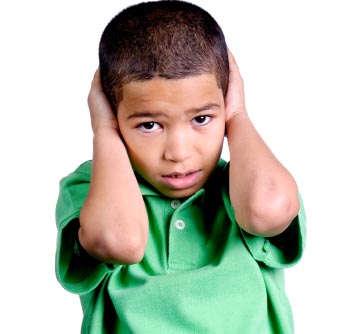From Science Daily
While Road Rippers Lightning Rods, Let's Rock Elmo and the I Am T-Pain musical microphone might be sought-after gifts this holiday season, parents should ensure that their children don't risk permanent hearing damage by misusing them.

Researchers from UC Irvine's Department of Otolaryngology measured the noise levels of two dozen popular toys in stores and purchased the 10 loudest for precise gauging in a soundproof booth at UC Irvine Medical Center. They found that all exceeded 90 decibels and several reached 100 or more, equivalent to the noise of a chain saw, subway train or power mower.
"Generally, toys are safe if used properly," said Dr. Hamid Djalilian, associate professor of otolaryngology and director of neurotology and skull base surgery. "We tested the sound levels at the speaker and again at 12 inches, which is about the length of a toddler's arm."
But problems can arise if a noisy toy is held too close to the ears, he said: "Children are very sensitive to loud and high-pitched sounds. Unfortunately, hearing loss from noise damage is permanent and not currently curable."
According to the American Academy of Otolaryngology, unprotected exposure to sounds above 85 decibels for a prolonged period can lead to hearing impairment. Two factors contribute to this, Djalilian noted: loudness and duration. The louder a sound is, the less time it takes to cause hearing loss.
He suggested that someone buying a noisy toy for a child pay attention to the speaker's location -- under the item is often better than on top. Djalilian also recommended that an adult hold the toy as a youngster would and listen to its sound. "If it hurts your ears," he said, "then it's probably too loud for a child."
Toys tested / Decibel level at the speaker / Decibel level 12 inches from the speaker:
- Road Rippers Lightning Rods / 108 / 68
- I Am T-Pain microphone / 101 / 64
- Tonka Mighty Motorized Fire Truck / 100 / 69
- Marvel Super Shield Captain America / 98 / 69
- Whac-A-Mole game / 95 / 69
- Tapz electronic reflex game / 95 / 65
- Sesame Street Let's Rock Elmo / 95 / 74
- VTech Magical Learning Wand / 94 / 69
- Toy Story Buzz Lightyear Cosmic Blaster / 93 / 60
- Green Lantern Colossal Cannon / 92 / 67
Image at http://www.healthyhearing.com/uploads/images/new/child-covering-ears.jpg


